In the vast online landscape, competition is fierce and unyielding. Every click, search, and scroll marks a battlefield where businesses vie to capture their target audience’s attention. In this digital arena, knowing and tracking your SEO competitors is necessary for survival and success.
That being said, let’s get this guide started! Read on as we unveil the secrets to finding competitor websites.
TL;DR
To succeed in search, you need a keen understanding of your SEO competitors. These are the websites that vie for visibility for the same keywords you’re targeting in your organic and paid campaigns.
You can kick off your competitive research with a manual search, inputting your keyword into Google or any other search engine. Though this is a fast and easy technique, it can get time-consuming on a large scale.
To streamline the process and get more comprehensive data, use dedicated competitor analysis tools like SE Ranking. This platform provides robust competitive research capabilities, including tools like Competitive Research, Visibility Rating, and SERP Analyzer.
With these tools, you can:
- Identify key organic and paid traffic competitors to learn from their strategies, identify growth opportunities, and allocate your marketing budget more effectively.
- Discover niche competitors to find fresh ideas from smaller, lesser-known, and specialized websites.
- Explore SERP competitors to pinpoint and learn from websites that are ranking for your target keywords.
What competitors you might want to find
When conducting competitor research, it is important to consider that there are a variety of competitor types. In digital marketing, especially SEO and Google Ads, the primary focus often centers on your SERP competitors — the websites targeting the same keywords as you in their search campaigns. You will need to make a clear distinction between your organic and paid search competitors.
To take your SEO analysis even deeper, you can single out your niche competitors based on the search visibility of your most wanted keywords. You can even focus on analyzing the specific pages you compete with in the SERPs for particular keywords.
Business-wise, your competitors can be divided into direct, partial, and indirect. All three of these competitor types can be found among the websites you compete with in organic and paid search:
- Direct competitors: These websites offer similar products or services to yours and target the same audience. They are your closest competitors and often compete directly for the same customers. For example, if you run an online clothing store, your direct competitors would be other online clothing stores catering to the same product types and target demographic.
- Partial competitors: Partial competitors are websites that share some overlap with your offerings, yet possess distinct focuses or specializations. They might serve a subset of your target audience or offer complementary products or services. For example, if you run an online clothing store specializing in sustainable fashion, your partial competitors could include online clothing stores that focus on plus-size clothing or affordable clothing.
- Indirect competitors: Indirect competitors are websites that target a similar audience but offer different products or services. While they might not be your primary competitors, they still compete for the attention and resources of your potential customers. For example, if you run an online clothing store, your indirect competitors might be websites that sell footwear, accessories, or home goods.
Look beyond the obvious: don’t just focus on your direct competitors. It’s possible to overlook other websites that are competing for your customers. That’s why you should always consider your target audience and ask yourself important questions: who are your target customers? What are their needs and wants? By getting to know your target audience, you can gain deeper insights into your competitors.
Why looking for competitors matters
Competitor research is an essential part of any digital marketing strategy because it enables you to complete several essential tasks:
- Improve your SEO: By understanding how your competitors are performing in search, you can better discern the factors contributing to their SEO success and fine-tune your own efforts accordingly. These insights can help you improve your website content and design, leading to higher rankings and more website traffic.
- Identify your strengths and weaknesses: By analyzing your competitors’ websites, you can identify the products and services they offer, pinpoint areas where they excel, and strategize ways to leverage these competitive advantages. This helps generate new ideas for improving your unique selling proposition and increasing brand awareness.
Now, let’s take a look at some effective strategies for finding competitors.
How to find competing websites
There are several ways to find competing websites, but let’s start by focusing on the two most convenient and commonly used:
- Manual search: This involves typing relevant keywords on search engines like Google and analyzing top search results (SERP competitors). After analyzing these websites, you’ll find both direct and indirect rivals. But keep in mind that this way is inefficient and hard to scale.
- Dedicated SEO tools: Use tools like SE Ranking’s SEO Competitor Checker to get comprehensive competitor website analysis features. These tools provide a thorough view of your competitive landscape and comprise an entire toolset for refining your digital strategy.
Let’s take a closer look at examples for both approaches.
Automated research with SE Ranking
SE Ranking offers a diverse set of tools for identifying your competitors in both organic search and paid advertising, providing key insights for comprehensive data-driven SEO strategies.
Let’s explore how to make the most of these tools.
Identifying organic search competitors with Competitive Research
To locate your direct and indirect organic competitors, use the Competitive Research tool. To start searching, just enter your website, or one of your direct competitor’s websites, and navigate to the Organic Traffic Research section.
Next, click on Competitors.
Here, you’ll discover websites drawing organic traffic from the same keywords you rank for in organic search.
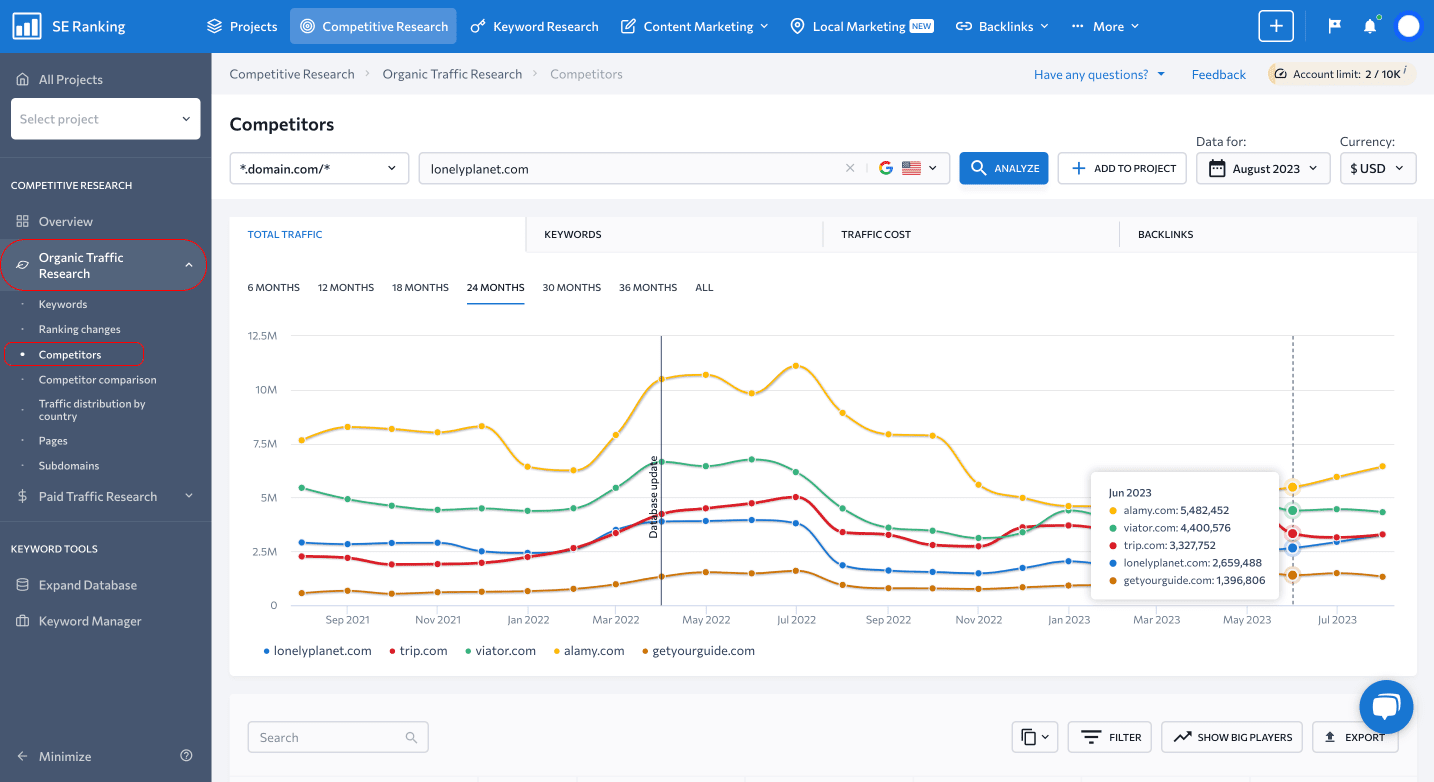
The chart offers a comparison between your website and up to four selected rivals. By default, it displays the top four rivals with the most common keywords, but you can manually adjust them using the table below. The tabs on the graph enable easy comparisons of total organic traffic, keyword count, estimated traffic cost, and number of backlinks.
With the option to view dynamics over different time periods—from the past 6 months to 3 years, and even more—this tool lets you effortlessly gauge your competitors’ parameters. It also provides valuable insights into your website’s performance relative to theirs.
Below the chart, you’ll discover a table with a list of all your organic search competitors. Each competitor is accompanied by crucial SEO metrics, including Domain Trust (DT), organic traffic, number of keywords, and estimated traffic cost. You can effortlessly filter, sort, and export data in either the XLS or CLS formats.
Clicking on a competitor’s domain redirects you to the competitor overview page, which consolidates all data about that specific domain. This includes essential information such as Domain Trust, Page Trust, organic and paid traffic data, referring domains, keywords, SERP features, top pages in organic and paid search, and more.
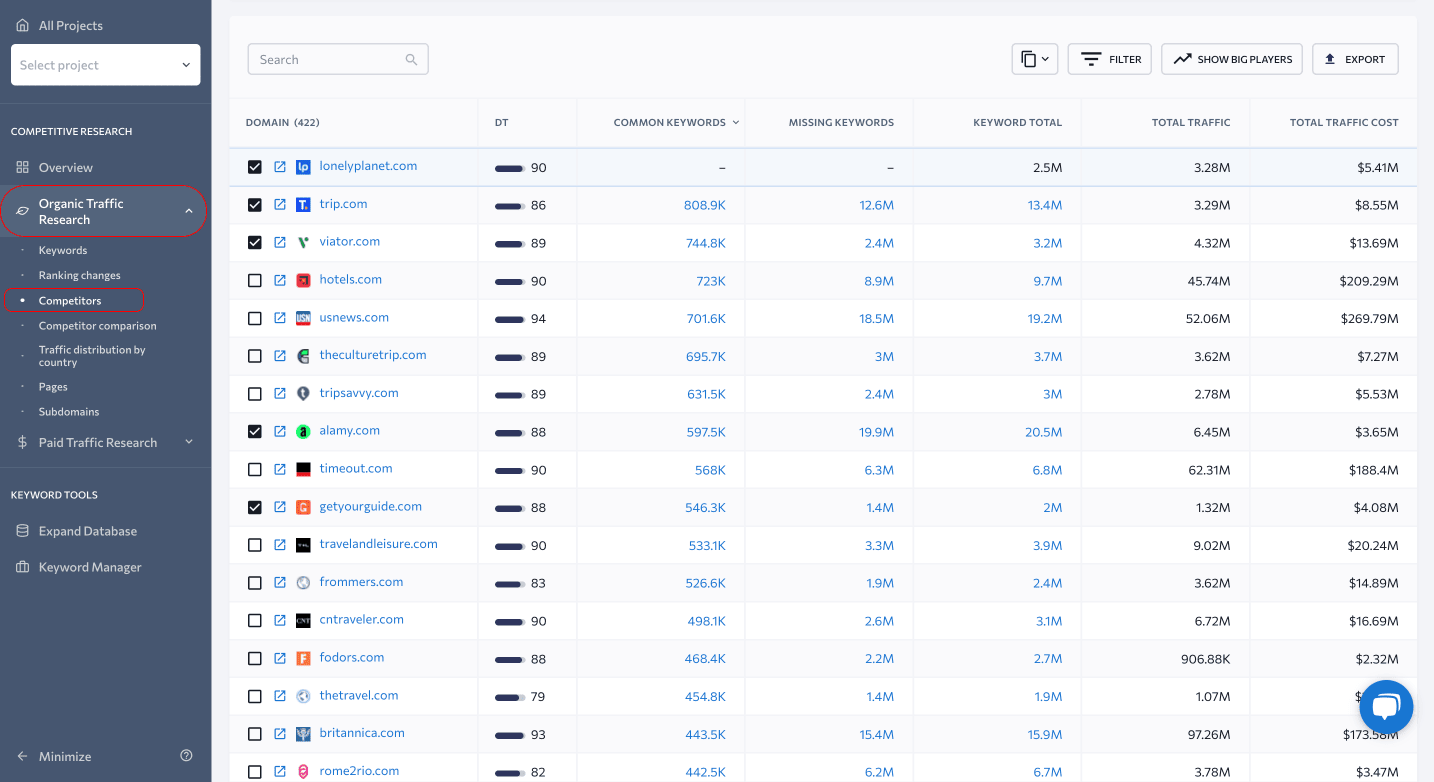
You will also be able to see the keywords shared by your competitors here. Competitors with a higher number of common keywords will rank higher on the list, indicating that they are your direct competitors. This section also reveals how many keywords you or your competitors may be missing.
Clicking on the number will take you to the Competitor Comparison section. This section provides valuable insights into the keywords you might be missing out on, allowing you to expand your keyword list.
Comparing your website to any two competing domains helps identify any keyword overlaps. Analyzing your website’s semantics alongside those of your competitors can uncover untapped keywords, presenting new opportunities for optimization.
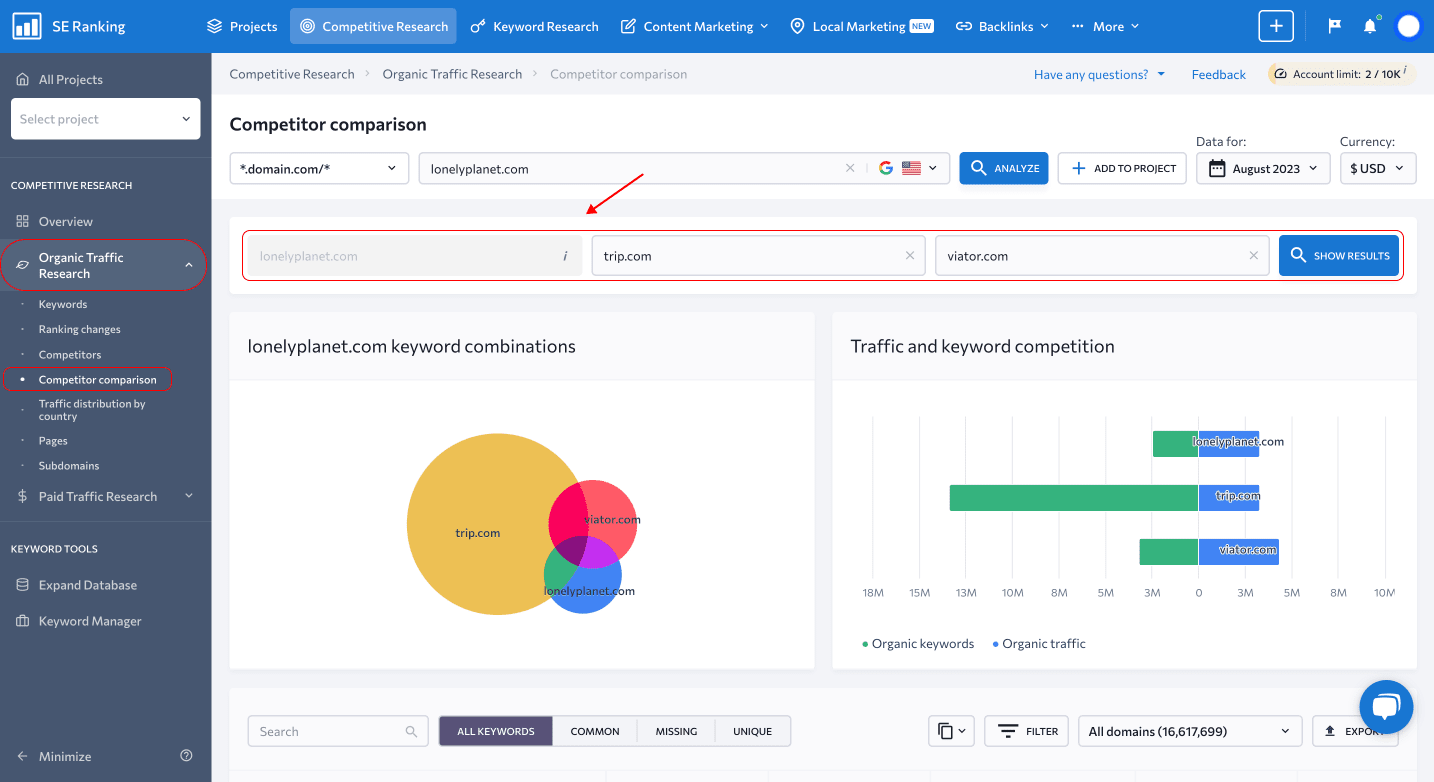
In this report, keywords are listed in the table below, showcasing common, missing, and unique keywords alongside their respective SEO metrics. You can compare factors like difficulty scores, search volume, available SERP features, competition level, and estimated cost per click. Use the filter to switch between lists and get the keywords you need. Leverage this data to identify valuable keywords worth incorporating into your project.
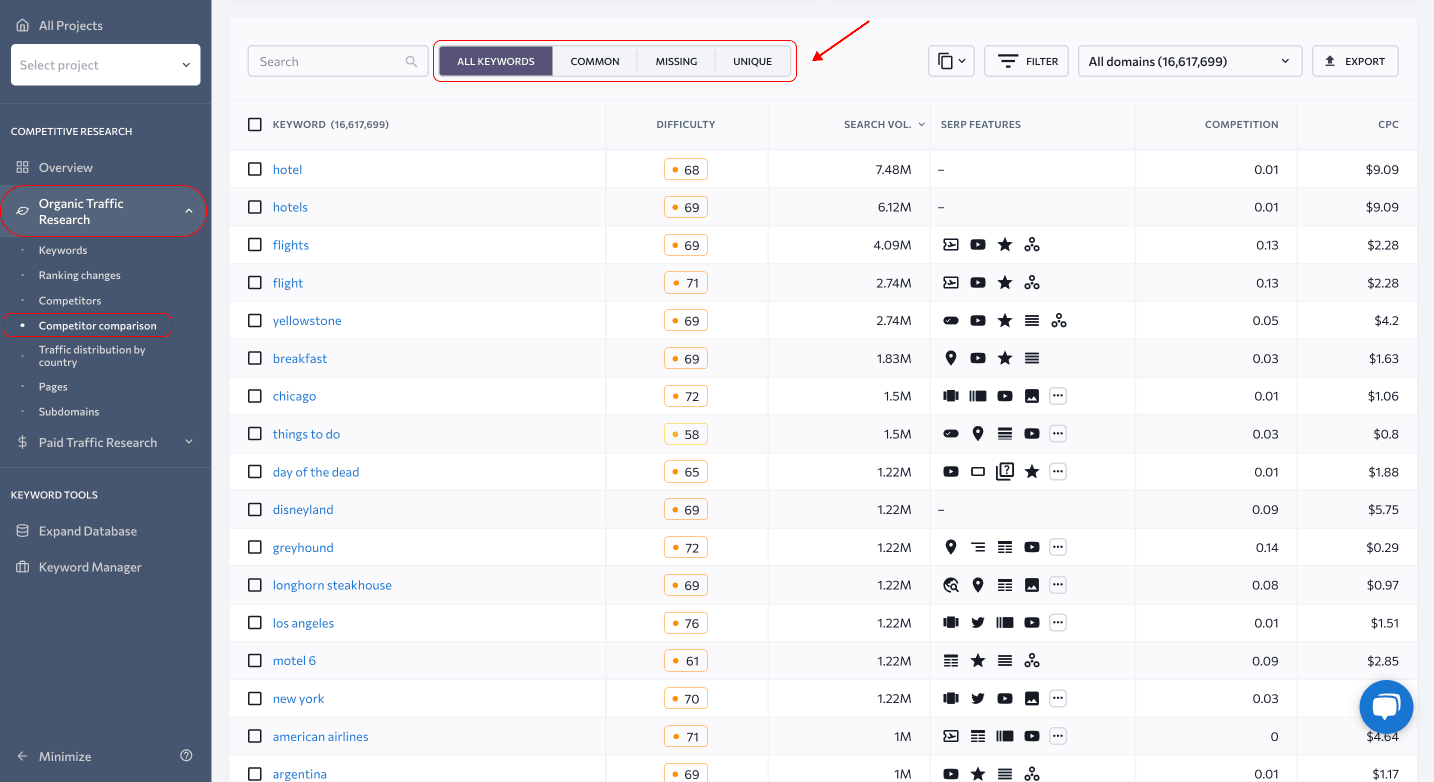
Identifying paid traffic competitors with Competitive Research
Switch to the Paid Traffic Research tab to discover competitors in Google Ads and gain valuable insights into their paid advertising data. The chart and table layout is similar to the organic search results, so navigating and comparing the data should be easy.
At the top of the dashboard, you’ll find a chart displaying the selected competitors in paid search. By switching tabs, you can compare their traffic, the number of keywords used for advertising, and the estimated traffic cost. The flexibility to compare data spans as far back as 36 months or even more, depending on your project settings.
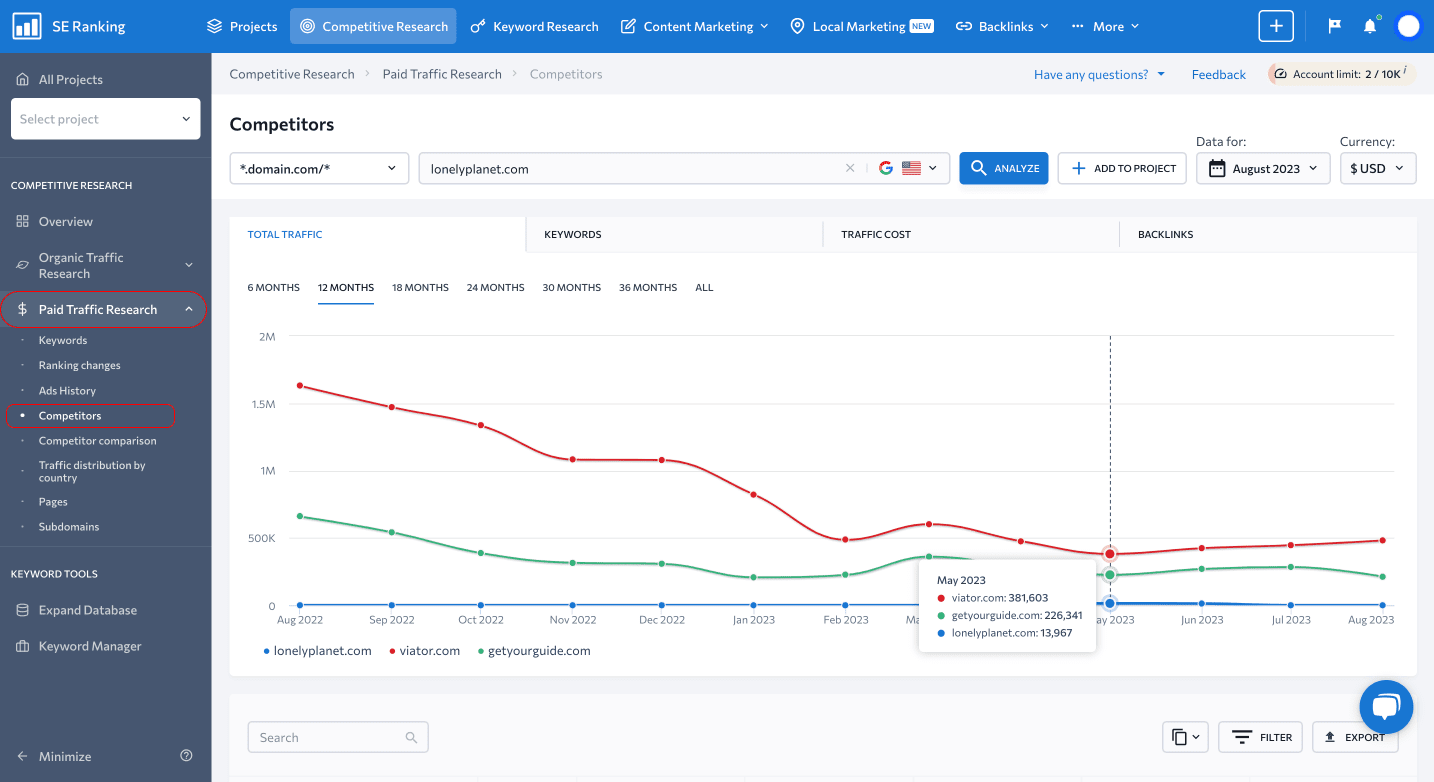
Below the chart, you will find a roster of paid search competitors. This list outlines their shared and missing keywords, total traffic, and traffic cost.
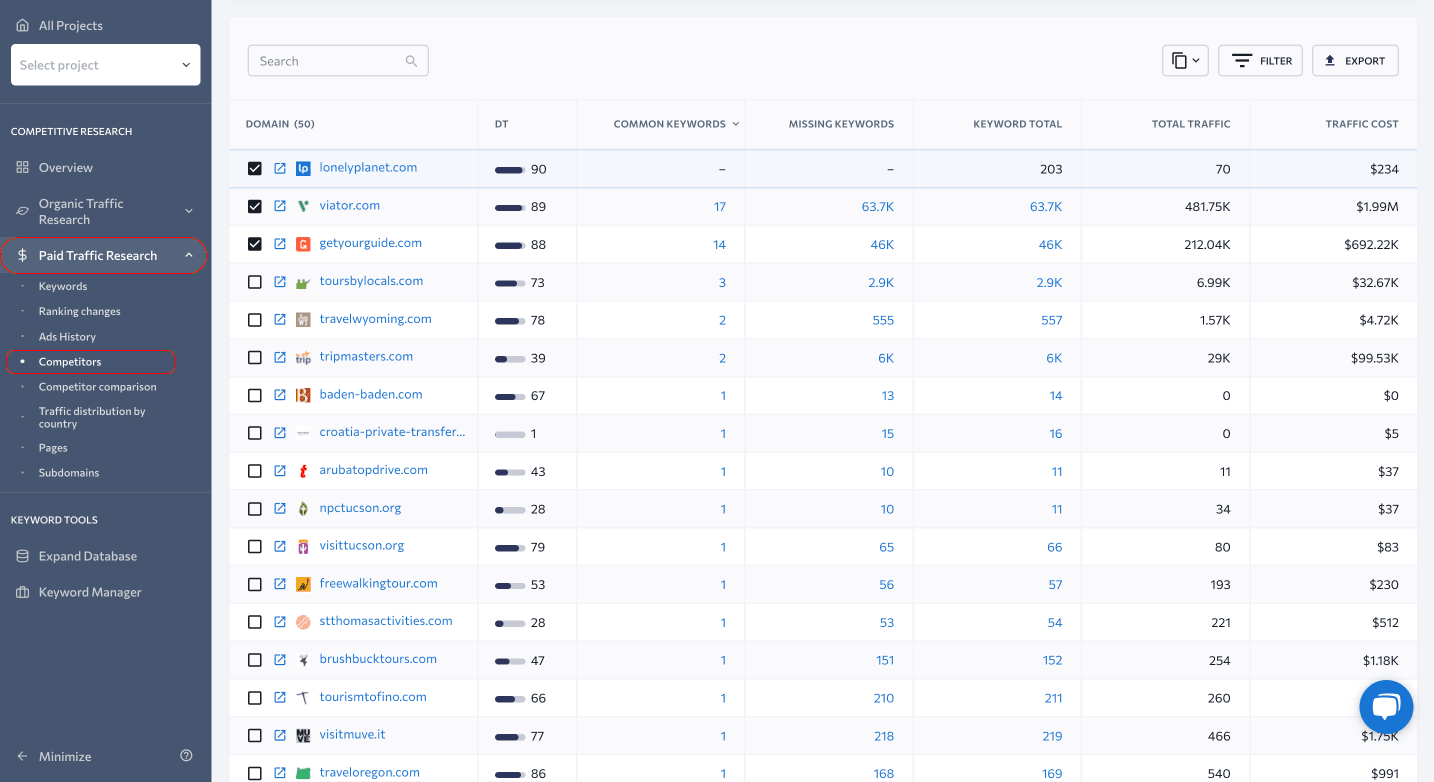
The Ads History section grants access to cached copies of your competitors’ ads, offering an in-depth view of the keywords they are using, their search volume, estimated cost per click, and the traffic they receive from these campaigns. This data can be easily exported to your preferred format.
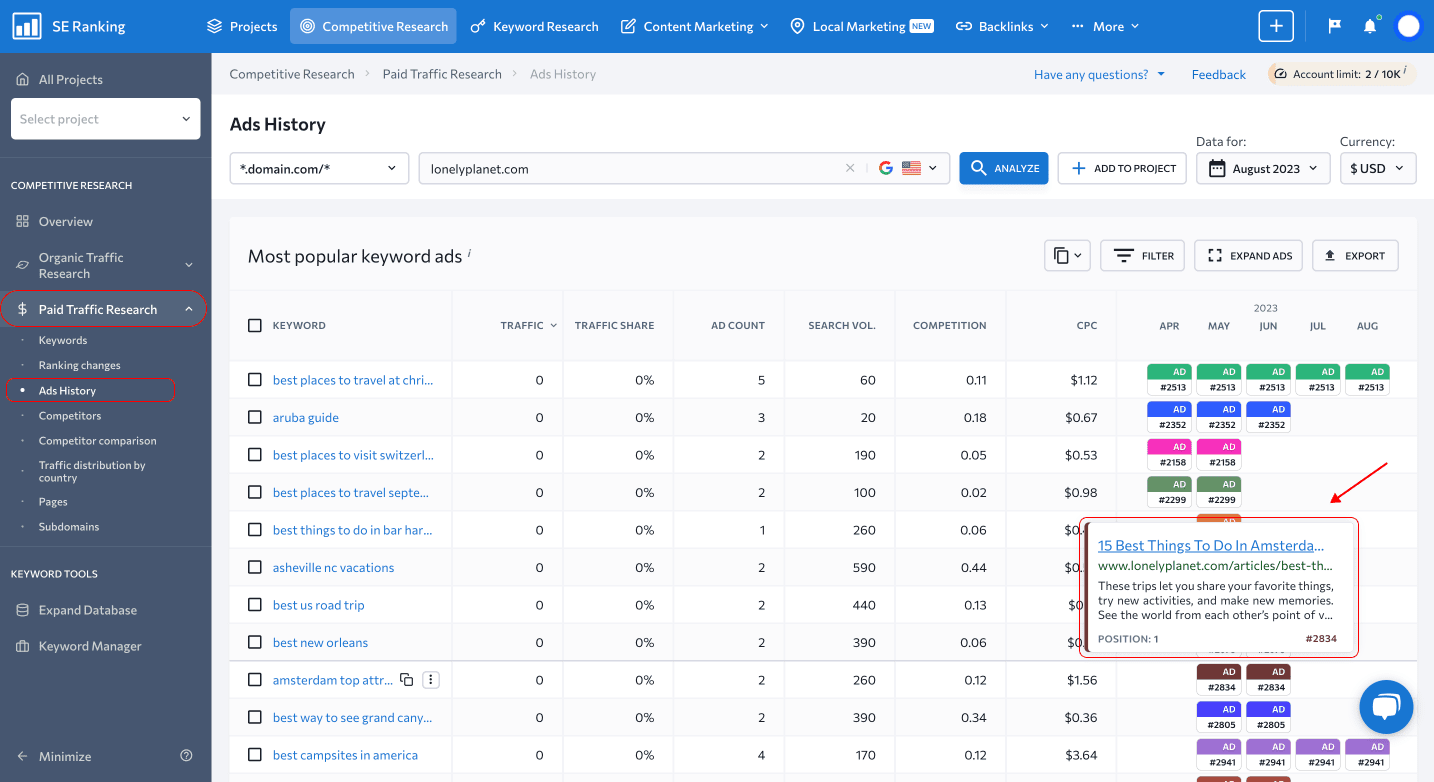
Identifying niche competitors with Visibility Rating
Another way to identify your competitors is by checking the Visibility Rating. Unlike Competitive Research, which encompasses all keywords a domain appears for in search, the Visibility Rating exclusively relies on the keywords you have added to the project for tracking. This approach affords a more targeted view on competitors within the niches you’ve selected for your current SEO project.
Depending on your chosen keywords and settings, the competitors you’ve identified might include both direct and indirect competitors. The higher the visibility score of a website, the closer it is to yours in terms of organic competition.
Keep in mind that this method requires knowing your target keywords and their inclusion in the project. This process might require more time, but it results in a more accurate and targeted list of competitors. To access this data, go to the Visibility Rating section in the My Competitors tool. By default, you’ll see competitors across all tracked keywords. To refine your search, use filters to focus on specific keyword groups or tags.
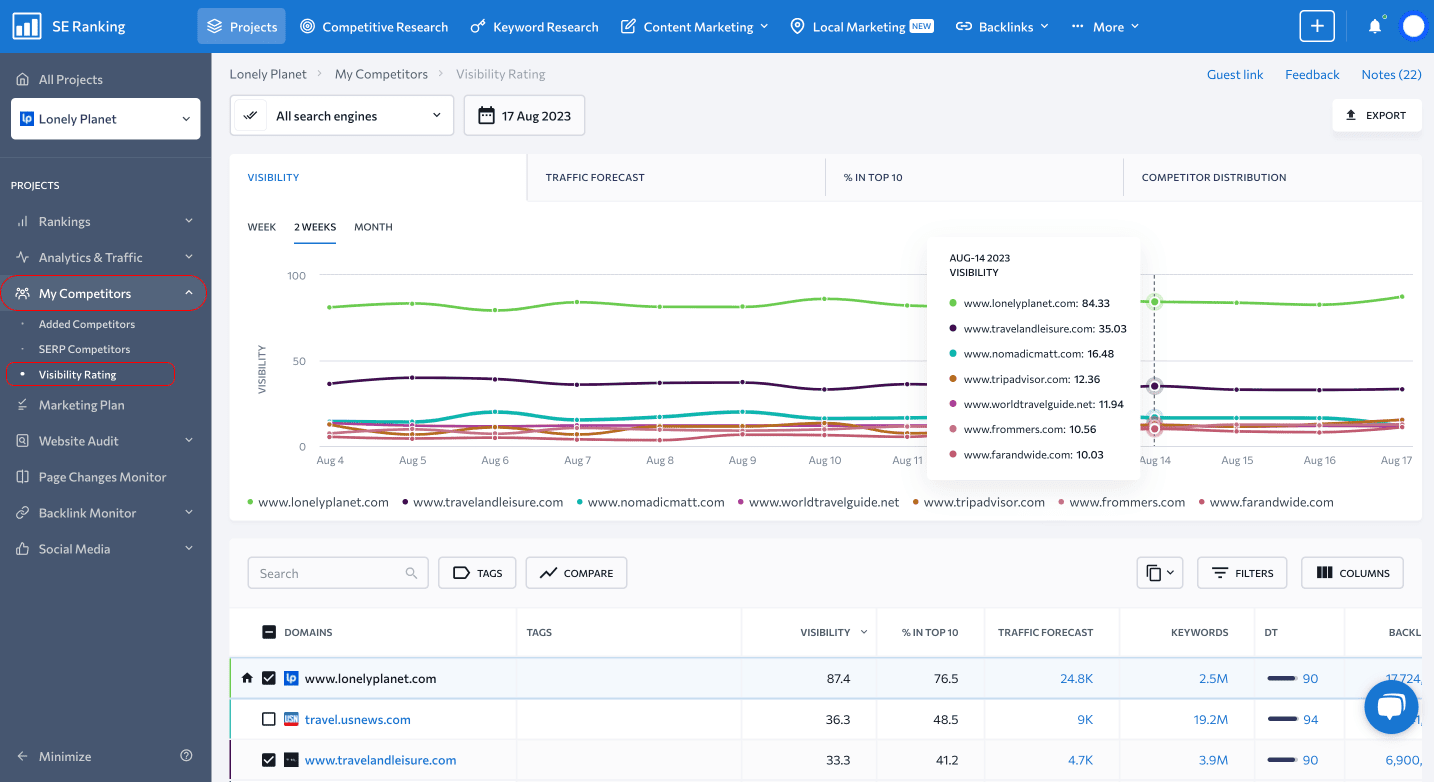
Within the dashboard, you’ll encounter a chart and table containing essential competitor data, such as visibility score, traffic forecast, keyword count, Domain Trust, backlinks, and referring domains. You have the option to detect competitors across all selected search engines, or focus on a specific one.
By toggling between chart tabs, you can compare your website’s performance with that of your competitors in terms of overall visibility, traffic forecast, and percentage of pages within the top 10 search results. Moreover, the chart lets you view the distribution of analyzed sites in the top ranks based on their average position and visibility.

Identifying SERP Competitors for specific queries
Another approach to gaining insights into the competitive landscape involves identifying your SERP competitors for specific search queries. Unlike previous techniques that focused primarily on website or domain/level analysis, this approach is based on a detailed analysis of search results pertaining to a particular search query or a cluster of related queries.
Granular data like this can be beneficial for tailoring your SEO efforts to specific tasks. What makes this approach especially valuable is that if you’re seeking to identify rapidly emerging newcomers, you can observe SERP fluctuations following Google updates, and trail the movements of specific competitors.
To use SE Ranking to identify prominent SERP competitors, navigate to the My Competitors tool and select the SERP Competitors tab. Here, you will find a list of up to 100 competitors (depending on the selected view mode) that appear in search results for the selected keyword. Toggle between the domain and URL modes to access additional information about the domains.
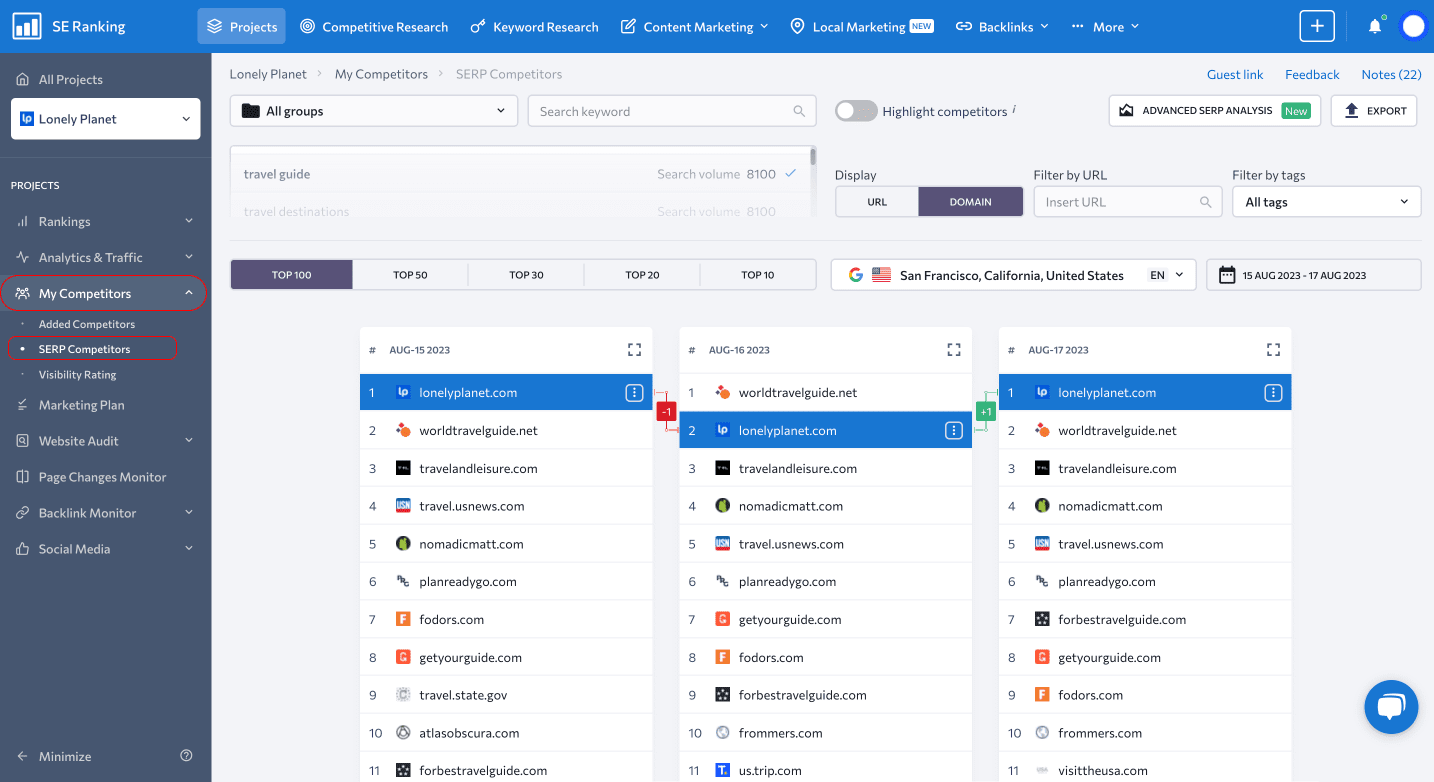
Begin by selecting your desired keywords at the top of the page. You can tailor the **** range according to your preferences and project settings to compare specific dates or analyze trends over a chosen period. Click on any competitor, and SE Ranking will highlight its position, enabling you to check the ranking dynamics. You can also opt for any location added to your project.
To gather even more data on your SERP competitors, use the advanced SERP Analyzer.
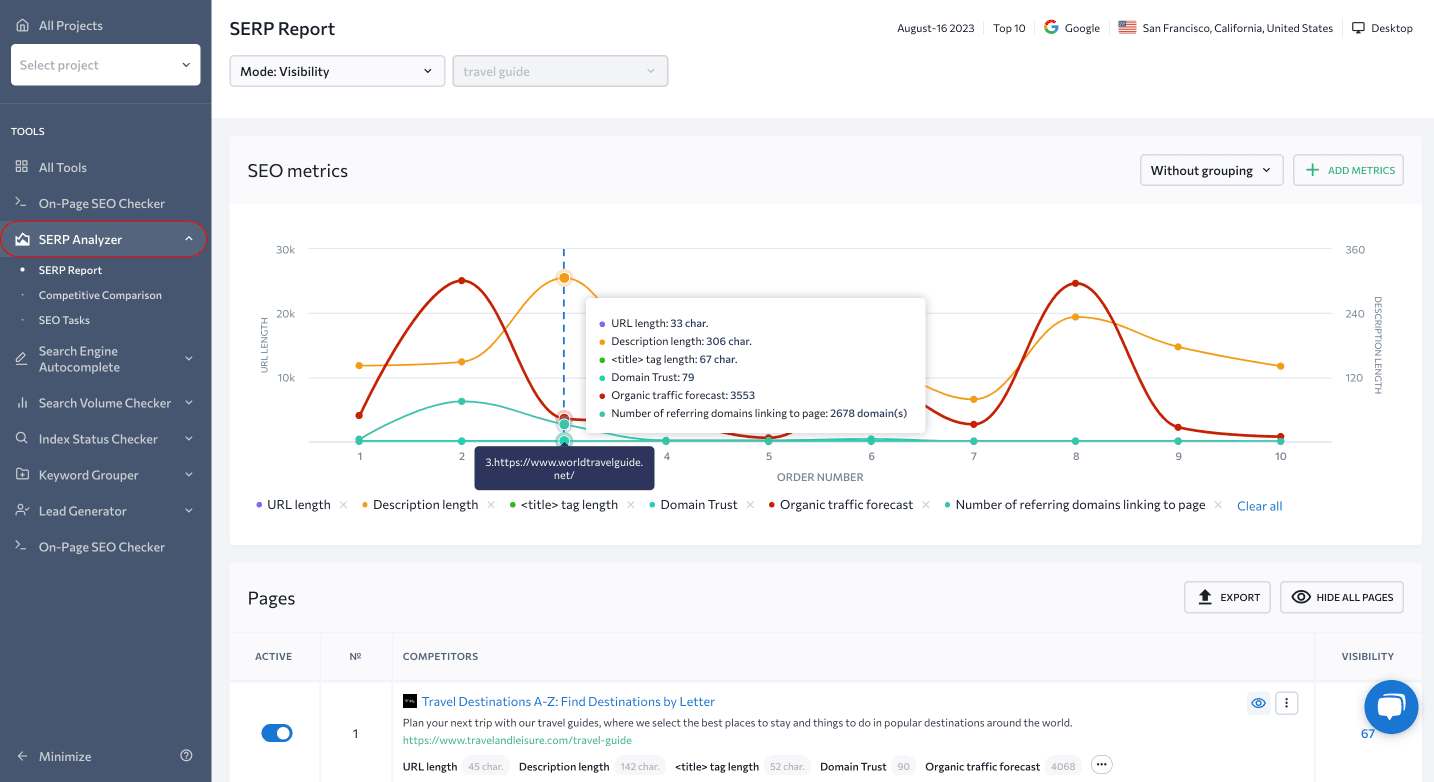
This tool not only lists the current search results for the selected keyword but also offers additional SEO data. It assesses key SEO metrics that influence your rankings and provides insights into what can be done to improve your position in the SERP.
Merely finding competitors is just the starting point. Staying ahead of the competition requires continuous monitoring and in-depth analysis of their activities. Explore our guide to discover the secrets of competitor analysis through the use of SE Ranking’s powerful tools and strategies.
Overall, SE Ranking is an invaluable tool for competitive intelligence. It streamlines and automates SEO tasks to enable faster and more accurate competitor identification.
Manual search through the SERP
In addition to utilizing specialized tools, consider using manual methods to find competitor websites.
The simplest approach involves entering relevant keywords associated with your industry or niche into search engines like Google. Review the top search results that appear and visit the websites that appear to be your competitors. Take a close look at their offerings, content, design, and overall user experience.
In the past, users used Google’s “related:” search operator to discover websites related to their industry or niche. But this technique is currently outdated, as Google has already announced its plan to drop support for this search operator.
Frequently asked questions
We’ve also gathered answers to some of the most common questions about competitive research.
How do I find competing websites?
There are plenty of ways to find competing websites, with the primary two being the use of special tools or manual searches. You can use SEO tools like SE Ranking, or you can conduct manual searches by entering your keywords in search engines like Google to discover relevant websites.
How do I find website competitors for free?
One completely free method involves conducting manual searches in search engines. Enter relevant industry keywords in Google or Bing, and then review the top search results to identify competing websites. Another option is to use free versions or trial periods of SEO tools that provide competitor analysis features.
Is it ******* to spy on competitors?
No. Researching and gathering information about your competitors is entirely legal. Not only that, it’s a common and widely accepted practice in online marketing. Avoid ******* activities such as *******, unauthorized access to private information, or spreading false information.
Which sites can help with competitor research?
Look for all-in-one SEO tools like SE Ranking, as they usually offer comprehensive content analysis features. These platforms also offer additional tools for discovering and evaluating your competitors, such as keyword research, backlink analysis, and content analysis.
How do you gather information about competitors?
You can gather information about competitors through a combination of methods. Utilize SEO tools to analyze their website performance, keywords, and backlinks. Carry out manual searches, explore social media platforms, subscribe to their newsletters, attend industry events, read industry publications, and monitor their content and marketing strategies.
Summary
What it all boils down to is this: finding your competitors’ websites will take you far in developing a successful digital strategy. By doing so, you can gain valuable insights, refine your approach, and outperform competitors in your niche. Whether you use specialized tools like SE Ranking’s Competitive Research tool or conduct manual searches, understanding who your competitors are and how they operate will empower you to optimize your own digital presence, attract more visitors, and achieve your business goals.
